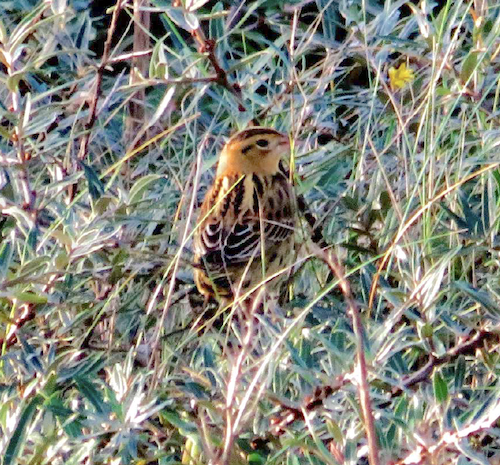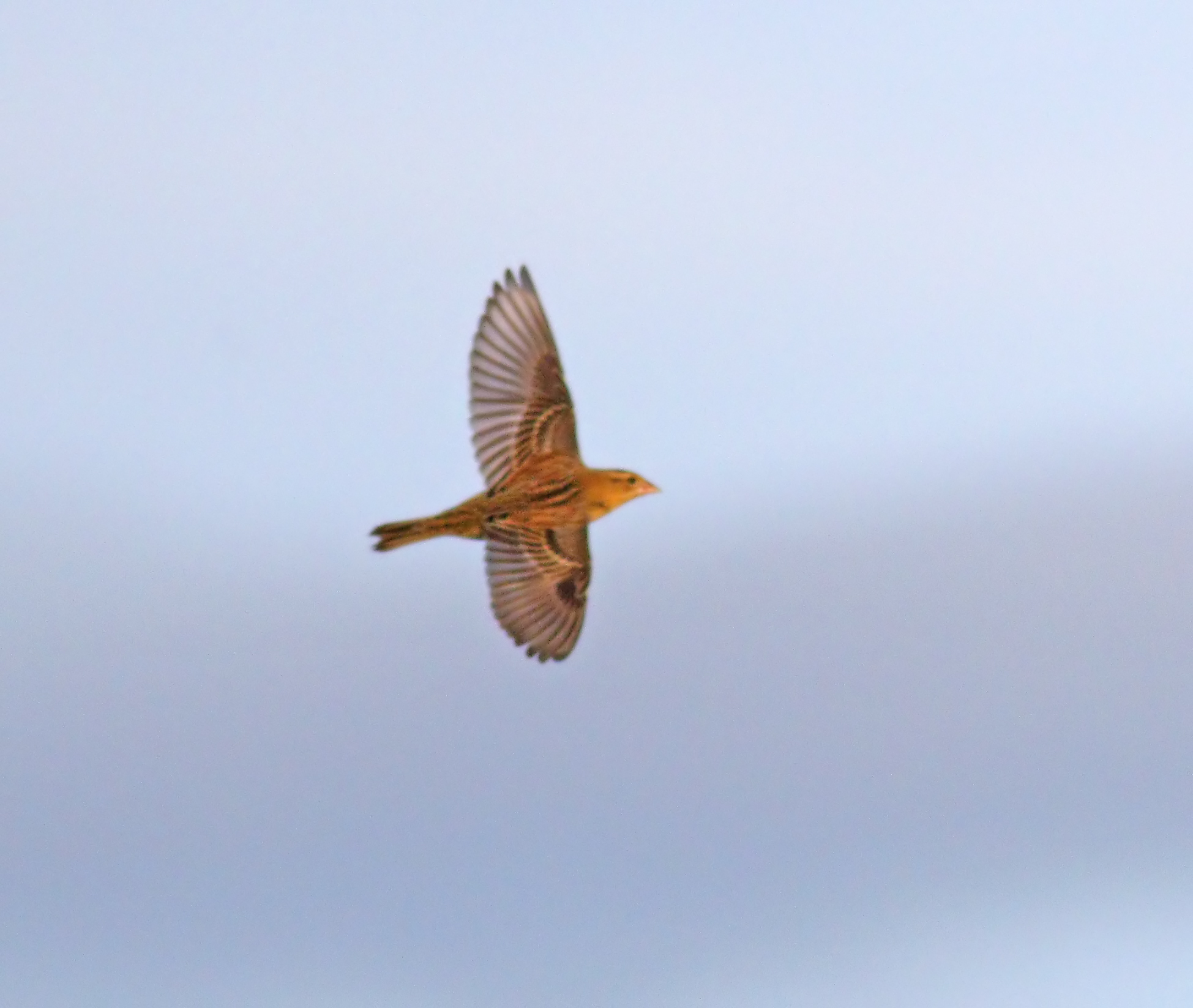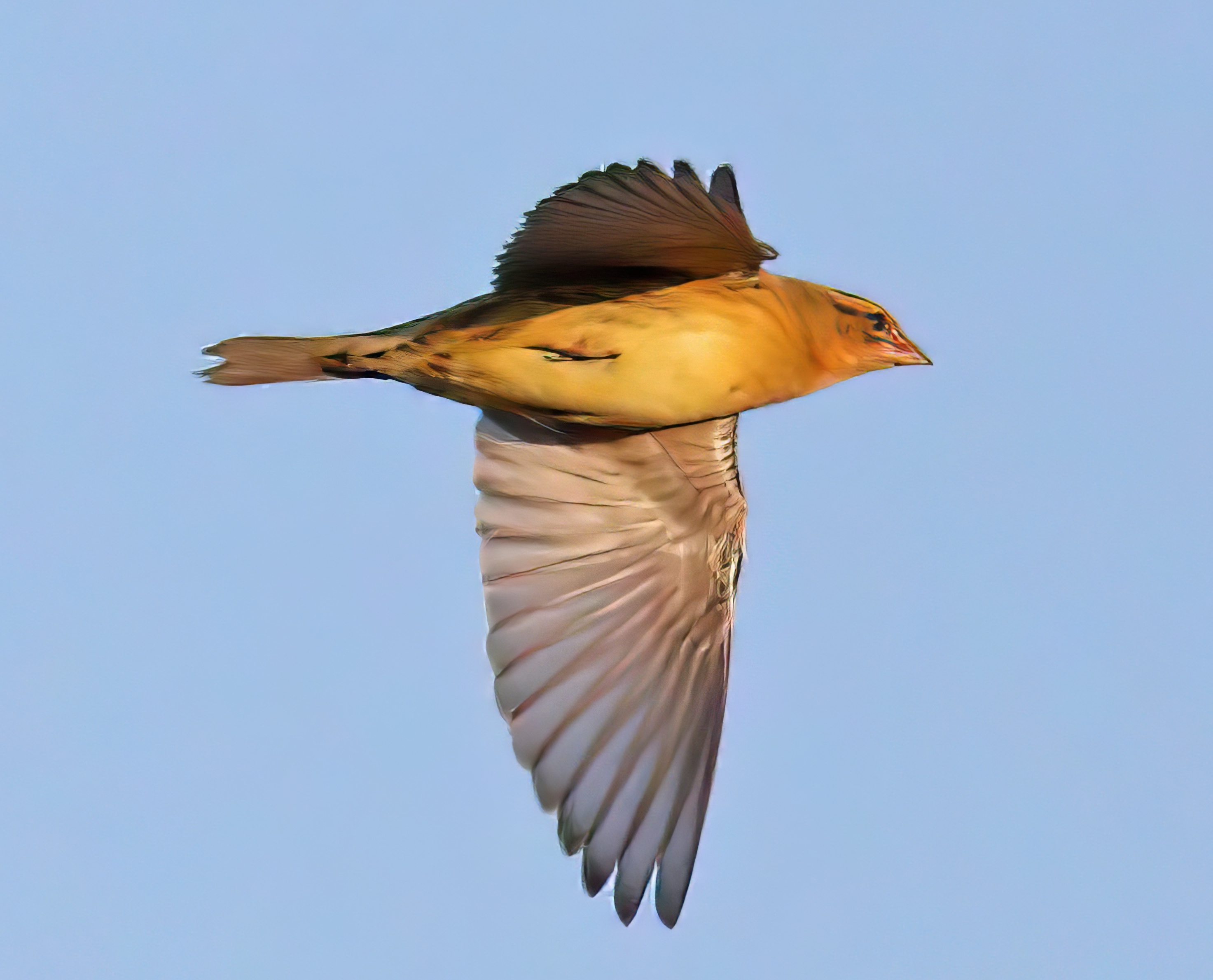Bobolink Dolichonyx oryzivorus
Vagrant. North America.



A juvenile Bobolink was found at Crook Bank, Saltfleetby-Theddlethorpe in October 2019 and was the first for record Lincolnshire. The morning in question was sunny with strong southerly winds, unlikely weather for a freshly arrived bird which had perhaps arrived earlier and further north in Britain. It frequented dense coastal vegetation along with some other finches and buntings and proved typically elusive. It did stay around long enough for a good number of county birders to see it but was gone by the next day. First recorded in Britain in 1962, on the Isles of Scilly, there has been a total of 33 in all including this individual. All have occurred between mid-September and early November. It is a much sought-after species, and this is the first in Britain since one on Shetland in 2012.
Bobolinks breed in the USA and Canada from British Columbia and Alberta south to Colorado in the west and to Newfoundland and as far south as West Virginia in the east. They are long-distance migrants crossing the Gulf of Mexico to winter in central or southern South America. Their round trips between breeding and over-wintering grounds extend to as much as 20,000 km, one of the longest annual migrations of any New World passerines.
| Site | First date | Last date | Count | Notes |
| Crook Bank, Saltfleetby-Theddlethorpe NNR | 18/10/2109 | - | 1 | 1CY bird |
Finder’s report: Bobolink at Crook Bank, Saltfleetby-Theddlethorpe NNR, October 18th 2019, first county record.
by Tom Hibbert (Birklands Ringing Group, Notts.).
Note: this account is based on the article which appeared in Lincolnshire Bird Report 2019. The BBRC report for 2019 noted that given the westerly bias to the previous records, it was not surprising that this bird was the first for Lincolnshire and only the second to reach the east coast of England (the previous bird was at Easington, Yorkshire, in October 2001). More surprisingly, this was the first since 2012 and this gap of seven years between records is the longest since that between the second and third records, in 1968 and 1975. The first British record was in 1962 and this brought the British total to 33 records.
Circumstances and description
There was nothing special about Friday the 18th October. It was my last full day of a week on the Lincolnshire coast, where I’d been staying with my partner, Lauren. The morning was surprisingly sunny, with strong southerly winds, and we’d seen very few birds on a wander through the dunes. A trickle of thrushes and finches moved south, but it felt quiet. My gut was telling me there was nothing around. Fortunately my instincts have never been more wrong!
We decided to head along Theddlethorpe beach in the hope of some early Snow Buntings. A few Skylarks fed on the beach, along with a large flock of Linnets, but nothing more exciting. We’d walked a few hundred metres when a call drew our attention to a bright male Yellowhammer, passing low overhead like a second sun. It dropped into the grass briefly, before taking to the air again. As the Yellowhammer took flight, two Reed Buntings popped up in a patch of sea buckthorn. I’d just raised my binoculars to take a closer look when another yellow bird exploded from the long grass.
I saw just enough to get a quick impression: a little larger than the two Reed Buntings, with a yellowish wash to the face and breast. I immediately knew this was something special - this was a bird I’d never seen before. But the view wasn’t enough to clinch an ID. For about twenty minutes it played hide and seek with us, skulking in the buckthorn and giving tantalising flashes of a plain face, boldly patterned head and heavy bill. I had a growing suspicion that I knew what it was, but I was sure I must be mistaken.
And then it finally hopped out into the open. It felt like a biblical moment, as if a ray of sunlight descended from the heavens to illuminate a bird I’d never dreamed of seeing in Britain, let alone finding on the East Coast. Two bright golden streaks ran down the mantle, bringing to mind an aquatic warbler. Dark lateral crown stripes, with a bright golden-brown median crown stripe added to this impression, but this was no warbler. The heavy pink bill, pale eye ring and thin dark line extending behind the eye all confirmed my suspicions. I’d just found a Bobolink!
My first thought was an incoherent babble. My second was that no one would believe this! I quickly grabbed my phone and tried to snap a few record shots through my binoculars, but before I’d managed more than a couple my battery died. I borrowed Lauren’s phone to put the news out, hoping other birders would be able to quickly get down and see it, then tried to keep an eye on it until more people arrived. This proved to be a challenge! The bird was a magician, creeping through the grass between clumps of buckthorn and popping up twenty feet from where we last saw it. Andy Lowe and Andy Ashley were in the nearby dunes, so were quickly on the scene, just in time for the bird to fly right over Andy L’s head, giving a weak “wink” call. It dropped into the biggest patch of sea buckthorn and disappeared.
By the time a small group had gathered, the Bobolink hadn’t shown itself for around half an hour and I was getting worried. At this point I didn’t know if I’d succeeded in capturing it on camera, and a growing crowd of birders had only my word to go on. Then finally it reappeared, giving brief flight views before disappearing into another dense cluster of buckthorn.Sadly I couldn’t stay to enjoy the bird. At that moment we got a phone call about a family emergency and had to head home immediately, but I’m glad many birders were able to connect with this surprising visitor. I was just as delighted that my frantic attempts at a record shot had paid off!
(Account as per new Birds of Lincolnshire (2021), included December 2022)

